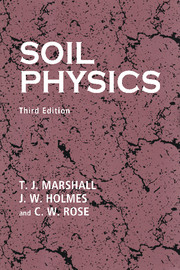Book contents
- Frontmatter
- Contents
- Preface
- Preface to the second edition
- Preface to the first edition
- 1 Composition of soil
- 2 Interaction of soil and water
- 3 Measurement of water content and potential
- 4 Principles of water movement in soil
- 5 Distribution of water in soil
- 6 Ground water in soils and aquifers
- 7 The use of isotopes and other tracers in soil water and groundwater studies
- 8 Soil structure
- 9 Deformation of soil
- 10 Management of soil water
- 11 Soil erosion and conservation
- 12 Chemical transport in soil
- 13 The physical environment of roots
- 14 Plants and soil water
- Appendixes
- References
- Index
10 - Management of soil water
Published online by Cambridge University Press: 05 June 2012
- Frontmatter
- Contents
- Preface
- Preface to the second edition
- Preface to the first edition
- 1 Composition of soil
- 2 Interaction of soil and water
- 3 Measurement of water content and potential
- 4 Principles of water movement in soil
- 5 Distribution of water in soil
- 6 Ground water in soils and aquifers
- 7 The use of isotopes and other tracers in soil water and groundwater studies
- 8 Soil structure
- 9 Deformation of soil
- 10 Management of soil water
- 11 Soil erosion and conservation
- 12 Chemical transport in soil
- 13 The physical environment of roots
- 14 Plants and soil water
- Appendixes
- References
- Index
Summary
Storage of water in soil
Within any given period the change, ΔW, in the amount of water stored in a zone between the surface and any particular depth in the soil can be represented as
Here the amounts added as precipitation, P, and irrigation, I, are balanced against the amounts lost in runoff from the surface, A, in underground drainage, D, and in evaporation from soil and plants (evapotranspiration), E, during the given period. Values can be negative for A when water runs on to the surface and for D when water comes to the root zone from below. Quantities are usually expressed in mm.
The amount of water in a soil horizon is given as a depth by
where z is the thickness of the horizon and θ, its volumetric water content, is the depth of water per unit depth of soil. A soil could ideally retain about 200 mm of water for plant use to a depth of 1 m. When such a soil is thoroughly wetted at the time of seeding, it retains enough water to enable a crop to grow to maturity provided none is lost to the atmosphere except through the crop. This has been demonstrated for maize in USA by Harrold et al. (1959), and it serves to illustrate the scope for conserving water in soil. Similarly, irrigation in Egypt before the nineteenth century relied upon the annual flood of the Nile without any supplemental watering.
- Type
- Chapter
- Information
- Soil Physics , pp. 248 - 273Publisher: Cambridge University PressPrint publication year: 1996



